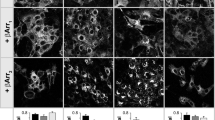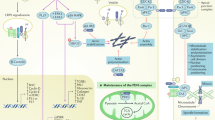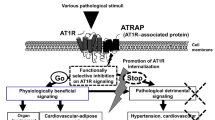Abstract
Several examples of functional G-protein–coupled receptor heterodimers have been identified. However, it is not known whether receptor heterodimerization is involved in the pathogenesis of human disorders. Here we show that in preeclamptic hypertensive women, a significant increase in heterodimerization occurs between the AT1-receptor for the vasopressor angiotensin II and the B2-receptor for the vasodepressor bradykinin. AT1–B2-receptor heterodimerization in preeclampsia correlated with a 4–5-fold increase in B2-receptor protein levels. Expression of the AT1–B2 heterodimer increased the responsiveness to angiotensin II and conferred resistance in AT1-receptors to inactivation by reactive oxygen species raised in normotensive and preeclamptic pregnancies. We suggest that AT1–B2 heterodimers contribute to angiotensin II hypersensitivity in preeclampsia. Moreover, we identify preeclampsia as the first disorder associated with altered G-protein–coupled receptor heterodimerization.
This is a preview of subscription content, access via your institution
Access options
Subscribe to this journal
Receive 12 print issues and online access
$209.00 per year
only $17.42 per issue
Buy this article
- Purchase on Springer Link
- Instant access to full article PDF
Prices may be subject to local taxes which are calculated during checkout





Similar content being viewed by others
References
Devi, L.A. G-protein–coupled receptor dimers in the lime light. Trends Pharmacol. Sci. 21, 324–326 (2000).
Bouvier, M. Oligomerization of G-protein–coupled transmitter receptors. Nature Rev. Neurosci. 2, 274–286 (2001).
AbdAlla, S., Lother, H. & Quitterer, U. AT1-receptor heterodimers show enhanced G-protein activation and altered receptor sequestration. Nature 407, 94–98 (2000).
Hubel, C.A. Oxidative stress in the pathogenesis of preeclampsia. Proc. Soc. Exp. Biol. Med. 222, 222–235 (1999).
Abdul-Karim, R. & Assali, N. Pressor response to angiotonin in pregnant and nonpregnant women. Am. J. Obstet. Gynecol. 82, 246–251 (1961).
Gant, N.F., Daley, G.L., Chand, S., Whalley, P.J. & MacDonald, P.C. A study of angiotensin II pressor response throughout primigravid pregnancy. J. Clin. Invest. 52, 2682–2689 (1973).
Oeney, T. & Kaulhausen, H. The value of the angiotensin-sensitivity test in the early diagnosis of hypertensive disorders in pregnancy. Am J. Obstet. Gynecol. 142, 17–20 (1982).
Cunningham, F.G. & Lindheimer, M.D. Hypertension in pregnancy. N. Engl. J. Med. 326, 927–932 (1992).
Douglas, K.A. & Redman, C.W.G. Eclampsia in the United Kingdom. Br. Med. J. 309, 1395–1400 (1994).
Masse, J., Forest, J.C., Moutquin, J.M. Degrandpre, P. & Forest, V.I. A prospective longitudinal study of platelet angiotensin II receptors for the prediction of preeclampsia. Clin. Biochem. 31, 251–255 (1998).
Pouilot, L., Forest, J.C., Moutquin, J.M. & Masse, J. Platelet angiotensin II binding sites and early detection of preeclampsia. Obstet. Gynecol. 91, 591–595 (1998).
De Jong, C.L.D., Dekker, G.A. & Sibai, B.M. The renin-angiotensin-aldosterone system in preeclampsia. Clin. Perinatol. 18, 683–771 (1991).
Haller, H., Oeney, T., Hauck, U., Distler, A. & Philipp, T. Increased intracellular free calcium and sensitivity to angiotensin II in platelets of preeclamptic women. Am. J. Hypertens. 2, 238–243 (1989).
AbdAlla, S., Zaki, E., Lother, H. & Quitterer, U. Involvement of the amino terminus of the B2 receptor in agonist-induced receptor dimerization. J. Biol. Chem. 274, 26079–26084 (1999).
Aalkjaer, C. et al. Abnormal vascular function and morphology in pre-eclampsia: A study of isolated resistance vessels. Clin. Sci. 69, 477–482 (1985).
Belfort, M.A., Saade, G.R., Suresh, M., Kramer, W. & Vedernikov, Y.P. Effects of selected vasoconstrictor agonists on isolated omental artery from premenopausal nonpregnant women and from normal and preeclamptic pregnant women. Am. J. Obstet. Gynecol. 174, 687–693 (1996).
Quitterer, U., Zaki, E. & AbdAlla, S. Investigation of the extracellular accessibility of the connecting loop between membrane domains I and II of the bradykinin B2 receptor. J. Biol. Chem. 274, 14773–14778 (1999).
Sullivan, J.M. et al. Identification of two cysteine residues that are required for redox modulation of the NMDA subtype of glutamate receptor. Neuron 13, 929–936 (1994).
Akoev, V.R., Matveev, A.V., Belyaeva, T.V. & Kim Y.A. The effect of oxidative stress on structural transitions of human erythrocyte ghost membranes. Biochim. Biophys. Acta 1371, 284–294 (1998).
Bellomo, G., Thor, H. & Orrenius, S. Alterations in inositol phosphate production during oxidative stress in isolated hepatocytes. J. Biol. Chem. 262, 1530–1534 (1987).
Tschope, C. et al. Myocardial bradykinin B2 receptor expression at different time points after induction of myocardial infarction. J. Hypertens. 18, 223–238 (2000).
Haddad, E.B. et al. Post-transcriptional regulation of bradykinin B1 and B2 receptor gene expression in human lung fibroblasts by tumor necrosis factor-α: modulation by dexamethasone. Mol. Pharmacol. 57, 1123–1131 (2000).
Pesquero, J.B., Lindsey, C.J., Paiva, A.C., Ganten, D. & Bader, M. Transcriptional regulatory elements in the rat bradykinin B2 receptor gene. Immunopharmacology 33, 36–41 (1996).
Quitterer, U., AbdAlla, S., Jarnagin, K. & Müller-Esterl, W. Na+ ions binding to the bradykinin B2 receptor suppress agonist-independent receptor activation. Biochemistry 35, 13368–13377 (1996).
Vagnoni, K.E. et al. Endothelial vasodilator production by uterine and systemic arteries. III. Ovarian and estrogen effects on NO synthesis. Am. J. Physiol. 275, H1845–H1856 (1998).
AbdAlla, S., Müller-Esterl, Quitterer, U. Two distinct Ca++ influx pathways activated by the bradykinin B2 receptor. Eur. J. Biochem. 24, 498–506 (1996).
Touyz, R.M. & Schiffrin, E.L. The effect of angiotensin II on platelet intracellular free magnesium and calcium ionic concentration in essential hypertension. J. Hypertens. 11, 551–558 (1993).
Rath-Hope, H. et al. Large-scale purification of myeloperoxidase from HL60 promyelocytic cells: Characterization and comparison to human neutrophil myeloperoxidase. Prot. Express. Purif. 18, 269–276 (2000).
Quitterer, U. & Lohse, M.J. Crosstalk between Gαi- and Gαq-coupled receptors is mediated by Gβγ exchange. Proc. Natl. Acad. Sci. USA 96, 10626–10631 (1999).
Author information
Authors and Affiliations
Corresponding author
Rights and permissions
About this article
Cite this article
AbdAlla, S., Lother, H., el Massiery, A. et al. Increased AT1 receptor heterodimers in preeclampsia mediate enhanced angiotensin II responsiveness. Nat Med 7, 1003–1009 (2001). https://doi.org/10.1038/nm0901-1003
Received:
Accepted:
Issue Date:
DOI: https://doi.org/10.1038/nm0901-1003
This article is cited by
-
Glomerular hyperfiltration
Nature Reviews Nephrology (2022)
-
Angiotensin AT1 and AT2 receptor heteromer expression in the hemilesioned rat model of Parkinson’s disease that increases with levodopa-induced dyskinesia
Journal of Neuroinflammation (2020)
-
Hypertensive Disorders of Pregnancy
Current Atherosclerosis Reports (2017)
-
Placental Ischemia and Resultant Phenotype in Animal Models of Preeclampsia
Current Hypertension Reports (2016)



